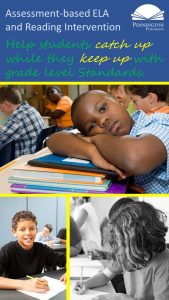Quick Reading Assessments
At the start of the school year or when they get the inevitable transfer students, veteran teachers realize that they can’t depend solely upon previous teacher or counselor placements with regard to student reading levels. Teachers don’t want to find out in the middle of a grade-level novel that some students are reading two or more years below grade level and can’t hope to understand the book without significant assistance. Teachers need quick reading assessments.
The best quick reading assessment? Reading. Specifically, a short reading fluency passage, but one that gives you not just a reading fluency number, but one that also gives you a good ballpark of what grade level the students can independently access. You’ve never seen anything like this before.
This “Pets” expository fluency passage is leveled in a unique pyramid design: the first paragraph is at the first grade (Fleish-Kincaid) reading level; the second paragraph is at the second grade level; the third paragraph is at the third grade level; the fourth paragraph is at the fourth grade level; the fifth paragraph is at the fifth grade level; the sixth paragraph is at the sixth grade level; and the seventh paragraph is at the seventh grade level.
Thus, the reader begins practice at an easier level to build confidence and then moves to more difficult academic language. As the student reads the fluency passage, the teacher will be able to note the reading levels at which the student has a high degree of accuracy and automaticity. Automaticity refers to the ability of the reader to read effortlessly without stumbling or sounding-out words. The 383 word passage and two-minute expository reading fluency is a much better measurement than a one-minute narrative reading fluency at only one grade level. The Pets Fluency Assessment is my gift to you and your students.
High levels of reading fluency are positively correlated with high levels of comprehension. Although not a causal connection, it makes sense that a certain degree of effortless automaticity is necessary for any reader to fully attend to meaning-making.
A good guideline that is widely used for acceptable fluency rates follows (Hasbrouk, Tindale).

The Science of Reading Intervention Program
The Science of Reading Intervention Program: Word Recognition includes explicit, scripted, sounds to print instruction and practice with the 5 Daily Google Slide Activities every grades 4-adult reading intervention student needs: 1. Phonemic Awareness and Morphology 2. Blending, Segmenting, and Spelling 3. Sounds and Spellings (including handwriting) 4. Heart Words Practice 5. Sam and Friends Phonics Books (decodables). Plus, digital and printable sound wall cards, speech articulation songs, sounds to print games, and morphology walls. Print versions are available for all activities. First Half of the Year Program (55 minutes-per-day, 18 weeks)
The Science of Reading Intervention Program: Language Comprehension resources are designed for students who have completed the word recognition program or have demonstrated basic mastery of the alphabetic code and can read with some degree of fluency. The program features the 5 Weekly Language Comprehension Activities: 1. Background Knowledge Mentor Texts 2. Academic Language, Greek and Latin Morphology, Figures of Speech, Connotations, Multiple Meaning Words 3. Syntax in Reading 4. Reading Comprehension Strategies 5. Literacy Knowledge (Narrative and Expository). Second Half of the Year Program (30 minutes-per-day, 18 weeks)
The Science of Reading Intervention Program: Assessment-based Instruction provides diagnostically-based “second chance” instructional resources. The program includes 13 comprehensive assessments and matching instructional resources to fill in the yet-to-be-mastered gaps in phonemic awareness, alphabetic awareness, phonics, fluency (with YouTube modeled readings), Heart Words and Phonics Games, spelling patterns, grammar, usage, and mechanics, syllabication and morphology, executive function shills. Second Half of the Year Program (25 minutes-per-day, 18 weeks)
The Science of Reading Intervention Program BUNDLE includes all 3 program components for the comprehensive, state-of-the-art (and science) grades 4-adult full-year program. Scripted, easy-to-teach, no prep, no need for time-consuming (albeit valuable) LETRS training or O-G certification… Learn as you teach and get results NOW for your students. Print to speech with plenty of speech to print instructional components.
Click the SCIENCE OF READING INTERVENTION PROGRAM RESOURCES for detailed program description, sample lessons, and video overviews. Click the links to get these ready-to-use resources, developed by a teacher (Mark Pennington, MA reading specialist) for teachers and their students.
Get the SCRIP Comprehension Cues FREE Resource:
![]()
Get the Diagnostic ELA and Reading Assessments FREE Resource:![]()
*****


